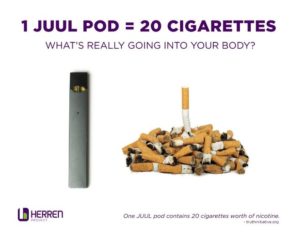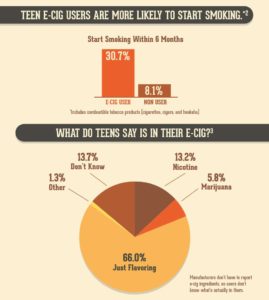Caitlin Mede, MS – CORA Drug and Alcohol Counselor
Megan Murphy – TIP Counselor/Early Intervention
What is a JUUL?
A JUUL is a type of electronic nicotine delivery system which was introduced to the United States market in 2015. The JUUL is a sleek and compact device that looks similar to a flash drive and the battery charges through a USB port. It is easy to use, discreet, and has no tobacco odor so it is often used in schools and other indoor environments unnoticed. The user purchases disposable “vape pods” which attach to the device and contain nicotine salts and flavors. The vape pods sold by JUUL come in attractive flavors such as mango, fruit medley, cool mint, menthol, cucumber, etc. The user can also purchase “skins” to decorate their JUULs with patterns of their choice. JUULs, vape pods, and accessories can be purchased in stores or online – therefore, even though it is promoted as a device for ages 21 and older, adolescents and children have still been able to acquire them.
The vape pod is heated through battery-operated coils which contain an e-liquid with 5% nicotine by weight. This is equivalent to about 1 pack of cigarettes. Newer generations of these devices tend to have a higher capacity battery, allowing for even more nicotine delivery than older devices.
How are JUUL Products Marketed and Advertised?


JUUL’s mission statement is “improving the lives of the world’s one billion adult smokers.” However, their marketing campaign tells a different story. Social media was their largest advertising platform including Instagram, Twitter, and Facebook. They even hired young social media influencers with large followings to promote JUUL products through the use of hashtags such as #JUUL, #JUULvapor, and #switchtoJUUL. Much of the imagery included young, attractive people using JUUL products, doing vape tricks, or making jokes with their device. Stanford conducted a critical analysis of their advertising strategies which suggested that JUUL was intentionally targeting the youth to be consumers of their products. The images below are some examples of how JUUL advertised to the youth.
Additionally, the company made claims that using a JUUL is much safer than cigarettes and that they would be approved by the Food and Drug Administration (FDA) any day. These claims are false and not based on any scientific evidence. As of recent, the FDA publicly accused JUUL of illegally marketing their products and ordered the company to correct these violations or they could face legal action. The FDA also recognized JUUL’s marketing and promotion practices for targeting youth through social media as well as doing presentations in schools and summer camps. Many believe that this was part of the company’s effort to become the largest e-cigarette brand in the nation.
JUUL vs. Traditional Cigarettes

Electronic nicotine delivery systems were proposed as a tool for smokers to utilize to quit smoking and reduce the harm related to smoking traditional cigarettes. However, the current research suggests that people are not actually using it for this reason. Studies are showing that those who use JUUL are actually more likely to smoke cigarettes as well, which raises concern for more severe nicotine dependence and health problems. In adolescents specifically, 75% of those who use JUUL also use other forms of tobacco and are more likely to continue smoking rather than quit.
It is well known that cigarette smoking causes major health problems. The Center for Disease Control and Prevention estimates that cigarette smoking causes 480,000 deaths each year (about one in five deaths) in the United States alone. These deaths primarily occur from cancer, respiratory disease, and cardiovascular disease. The introduction of e-cigarettes and JUUL have people wondering if the risks are the same or if these devices are a healthier alternative.
Health Risks Related to JUUL
Since these devices are so new, the research is limited, especially regarding the long-term health effects. However, based on what we know so far, professionals are saying that they are ultimately unsafe. JUULs contain nicotine, aerosol, ultrafine particles, heavy metals, and volatile organic compounds. When these are inhaled into the lungs they may cause serious problems for those who are actively using and those who are exposed to secondhand vaping. Health professionals and scientists believe that e-cigarettes and JUULs put individuals at risk for heart
attack, stroke, coronary artery disease, lung damage, seizures, reproductive health, and mental health issues such as depression.
The federal health authorities are currently investigating 450 cases, including five deaths, of pulmonary disease related to vaping. The definitive causes of these illnesses are unknown but the likelihood that e-cigarettes play a role is high. A large number of these individuals were using marijuana products but some of them used nicotine only.
How Does Nicotine Affect the Developing Brain?
What we know about nicotine and how it affects the brain is still relevant and worrying when considering the use of e-cigarettes and JUULs. The part of the brain which is responsible for making decisions and controlling impulses is not fully developed during adolescence. This means that adolescents and young adults are more likely to engage in risky behaviors that could negatively impact their health and safety, such as using nicotine and other drugs. When the adolescent or young adult brain is exposed to nicotine, they are uniquely at risk for long-term effects including addiction, mood disorders (i.e., depression, anxiety), permanent deficits in impulse control, and damage to the part of the brain which controls attention and learning.

Myths about JUUL
Myth: JUULs are less dangerous than smoking and other e-cigarettes.
Fact: Nicotine has negative effects on brain development, specifically the prefrontal cortex which is responsible for cognitions, behavior, and decision making; thus, putting adolescents at greater risk for further drug use. JUULs contain nicotine salts rather than freebase nicotine which makes it more readily absorbed into the bloodstream and less harsh, so it is easier to inhale nicotine for longer periods of time.
Myth: The JUUL does not contain nicotine.
Fact: According to the American Academy of Pediatrics, one JUUL pod contains nearly double the amount of nicotine than other e-cigarettes. One JUUL pod also contains the same amount of nicotine as one pack of cigarettes. Studies show that many teens who use the Juul do not think that they contain nicotine because they are advertised with flavors such as mango, crème Brule, and fruit medley. Additionally, when JUUL was first released and advertised the company did not state the nicotine content on the packaging.
Myth: Aerosol is as harmless as water vapor.
Fact: Aerosol contains toxic chemicals that can lead to cancer, as well as lung and respiratory diseases.
Myth: JUULs are not addictive.
Fact: JUULs have twice as much nicotine than other e-cigarettes, which increases the risk of addiction as well as the risk of teens using alcohol and other drugs.
How to Talk to your Teens about JUUL?
Do the research to learn about the products and the risk factors of using a JUUL. Establish a safe environment where there is no judgment and have a conversation. Don’t be afraid to ask questions. Teens thrive from boundaries. Have your teen research the effects of JUUL with you. Listen to what your teen has to say. Find out why your teen started using a JUUL. Discuss ways to get around peer pressure and develop a plan.
Caitlin Mede, MS – CORA Drug and Alcohol Counselor
Megan Murphy – TIP Counselor/Early Intervention
References:
Bayly, J. E., Bernat, D., Porter, L., & Choi, K. (2019). Secondhand Exposure to Aerosols from Electronic Nicotine Delivery Systems and Asthma Exacerbations Among Youth With Asthma. Chest, 155(1), 88–93. https://doi-org.ezproxy.pcom.edu/10.1016/j.chest.2018.10.005
Belluz, J. (2019). The vape community Juul said it doesn’t target teens. Its early ads tell a different story. Vox.Com. Retrieved from https://www.vox.com/2019/1/25/18194953/vape-juul-e-cigarette-marketing
Belluz, J. (2019). Vaping gone viral: the astonishing surge in teens’ e-cigarette use. Vox.Com. Retrieved from https://www.vox.com/science-and-health/2018/12/18/18144951/juul-vaping-e-cigarettes
Capritto, A. (2019). Is Juul bad for you? Doctors weigh in. Cnet.com. Retrieved from https://www.cnet.com/news/is-juul-bad-for-you-doctors-weigh-in/
Case, K. R., Hinds, J. T., Creamer, M. R., Loukas, A., & Perry, C. L. (2019). Who is JUULing and Why? An Examination of Young Adult Electronic Nicotine Delivery Systems Users. Journal of Adolescent Health. https://doi-org.ezproxy.pcom.edu/10.1016/j.jadohealth.2019.05.030
Centers for Disease Control and Prevention [CDC]. (2018). Health effects of cigarette smoking. Retrieved from https://www.cdc.gov/tobacco/data_statistics/fact_sheets/health_effects/effects_cig_smoking/index.htm
Chaykowski, K. (2018). The Disturbing Focus Of Juul’s Early Marketing Campaigns. Forbes.Com, 9. Retrieved from https://search-ebscohost-com.ezproxy.pcom.edu/login.aspx?direct=true&db=heh&AN=133078342&site=eds-live&scope=site
Fadus, M. C., Smith, T. T., & Squeglia, L. M. (2019). The rise of e-cigarettes, pod mod devices, and JUUL among youth: Factors influencing use, health implications, and downstream effects. Drug and Alcohol Dependence, 201, 85–93. https://doi-org.ezproxy.pcom.edu/10.1016/j.drugalcdep.2019.04.011
Huet, E. (2019). Juul Targeted Children at Schools and Online, U.S. House Panel Says. Bloomberg.Com, N.PAG. Retrieved from https://search-ebscohost-com.ezproxy.pcom.edu/login.aspx?direct=true&db=heh&AN=137725158&site=eds-live&scope=site
McGinley, L. (2019). FDA blasts Juul for illegally marketing e-cigarettes as less harmful than regular cigarettes. Washingtonpost.com. Retrieved from https://www.washingtonpost.com/health/2019/09/09/fda-bashes-juul-illegally-marketing-vaping-products-less-harmful-than-cigarettes/?noredirect=on
Middlekauff, H. R. (2019). Cardiovascular impact of electronic-cigarette use. Trends in Cardiovascular Medicine. https://doi-org.ezproxy.pcom.edu/10.1016/j.tcm.2019.04.006
Morean, M. E., Bold, K. W., Kong, G., Gueorguieva, R., Camenga, D. R., Simon, P., … Krishnan-Sarin, S. (2019). Adolescents’ awareness of the nicotine strength and e-cigarette status of JUUL e-cigarettes. Drug and Alcohol Dependence, 204. https://doi-org.ezproxy.pcom.edu/10.1016/j.drugalcdep.2019.05.032
United States Department of Health and Human Services. (2019). The facts on e-cigarette use among youth and young adults. Retrieved from https://e-cigarettes.surgeongeneral.gov/
